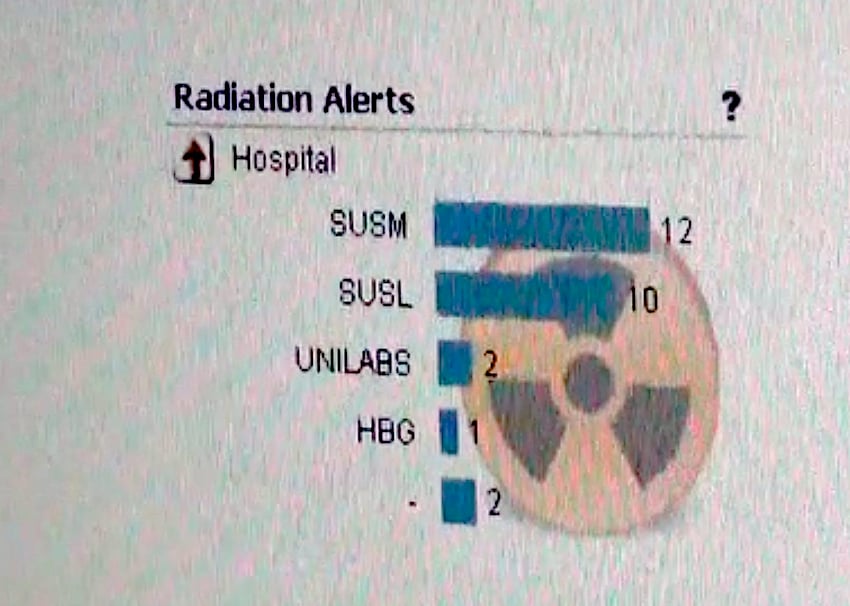Radiation dose continues to rise as the number of computed tomography (CT), nuclear, angiography and fluoroscopy examinations grow, leading to a greater risk of patient overexposure to radiation. Healthcare providers must reinforce their efforts to monitor and visualize dose levels from radiology examinations to enhance patient safety and meet new regulatory demands. There also is a need to justify and optimize the usage of radiation dose to find a balance between safer practice, image quality and lower dose — all for the benefit of the patient. Implementing tools for automatic and continuous follow up of radiation dose is at the forefront of meeting these challenges.
Gathering Radiation Dose Data
Gathering dose data is the first step in the optimization process. This is already done at many hospitals by the physics department, but it is often not an automated or a continuous process. Typically, dose data is collected when a cause for concern is raised for some reason or as a recurring quality control measure. A more systematic approach is implementing a permanent solution for automated collection of dose data from all modalities.
Newer modalities support the Integrating the Healthcare Enterprise (IHE) profile radiation exposure monitoring and/or the DICOM MPPS standard. This functionality allows dose to be collected automatically from the modality in real time and without human intervention.
But even with a dose monitoring solution in place, challenges in gathering data may persist. Mats Nilsson, professor in the Department of Medical Radiation Physics, Malmo University Hospital, Region Skane, Sweden, who has years of experience working with region-wide dose monitoring, shares some advice.
“When working across an entire region with several hospitals as we do, standardization is crucial for efficient follow up,” he explains. “You must have clear routines in place. Which exams can be reported together? Which should have separate exam codes? How do you name modalities and how, and in which, DICOM tag should the exam code be stored?”
Monitoring, Analyzing and Finding Best Practice
A dose monitoring solution can provide both the quick overview needed in day-to-day operations as well as the in-depth analysis required to implement ALARA (as low as reasonably achievable) principals. The standard dashboards include automatic alerts indicating when a patient has received an abnormal dose level or signals that show when a modality for some reason is not sending correct dose data, for example, following an upgrade.
The in-depth analysis enables benchmarking between different modalities, different hospitals, or even different technologists and doctors to develop best practices.
Visualizing Radiation Dose Data
It is important to increase awareness about the dose levels attached to different examinations throughout the entire healthcare chain. The interest in dose monitoring needs to spread from the physicists to radiologists, technologists and clinicians. With the dose information at hand, better decisions can be made, answering such questions as: Which type of follow-up examination is optimal? Given the higher dose level, is the CT exam really necessary or is a regular X-ray sufficient?
“Showing the dose level for each examination will create a curiosity about dose. That is an important first step in raising the discussion and finding the optimal balance between dose and diagnostic quality,” says Peter Leander, regional chief medical officer at Malmo University Hospital, who has CT dose optimization on the very top of his priority list.
Dose Data that Follows the Patient
The risk of over-radiation is normally not the dose given in a specific examination, but the cumulative dose given to a patient over time. This means that the dose data should not only be gathered and kept at a specific hospital or clinic, but it needs to follow the patient throughout their life. The solution to this challenge will differ between countries. This varies from national registries and patient portals to a patient owning the data in their personal record.
Efficient Reporting to Authorities
Given the focus that is put on radiation dose levels, it is just a matter of time before authorities will demand continuous reporting on radiation dose from healthcare providers. This is not only for control purposes, but also to build up a reference database. By comparing radiation dose levels not only in a single hospital but in a region or even in an entire country, broader guidelines and improvements can be implemented.
“With the dose at hand, a flexible dose monitoring solution will enable the necessary reports to be created with just a few clicks,” says Ian Judd, product manager for Sectra’s dose monitoring solution. “I have met several healthcare providers who do this manually today spending days or even weeks to collect and summarize the data. With the increased demands from authorities, that will simply not cut it.”
Healthcare providers need to implement efficient means of collecting radiation dose statistics, reporting to authorities and visualizing dose data throughout the healthcare chain. This is the foundation that can enable an optimization of dose levels – all for the benefit of the patient. It is a natural next step to increase patient safety and inevitably, a necessary demand being put forward by authorities.
Editor’s note: Mats Björnemo is director product marketing at Sectra.


